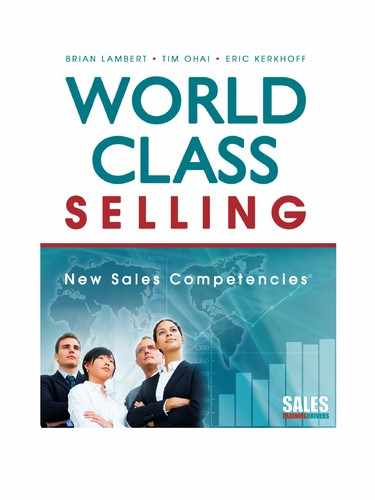Preface
Now is an exciting time to be in the sales field. As the profession continues to evolve, sales professionals will find that their work is frequently redefined as organizations rethink their business strategies and objectives in the face of economic uncertainty, new opportunities, and constant change. And while these challenges may affect many organizations regardless of industry or geography, one thing is certain: Having a competent and confident sales force can help an organization grow and achieve a competitive advantage.
The tactics of professional selling are well defined. Any bookstore features shelves full of volumes on identifying opportunities, defining cost of ownership, negotiating, using closing techniques, managing time, and exerting influence. A well-documented and well-defined competency model does not seek to replace those books, training methodologies, or practices. What a well-defined competency model can do is provide functional and commonly accepted expectations about what people need to know and do to be successful in the sales profession. It is a framework, rather than a technique. More important, the well-researched ASTD World-Class Sales Competency Model provides global insight into and standards for the critical human link required for world-class selling.
The outcomes of this research study are groundbreaking; the implications are far-reaching and relevant to a broad audience. Because the study defines sales competencies, as well as key actions and outputs required for all sales professionals, it can benefit sales managers, salespeople, sales trainers, sales coaches, sales consultants, sales operations team members, academics, and sales recruiters. The results of the study also provide numerous benefits to workplace learning and performance (WLP) professionals. WLP professionals are those individuals who are called upon by organizations to manage employee learning, training, and development; measure its impact on performance; and demonstrate business results based on improved performance.
To paraphrase John Coné, former chief learning officer for Dell, WLP professionals are more than just developers of people; they are enablers of outcomes and instruments for change. They help people grow, learn, and realize potential that, in turn, helps organizations perform at a higher level. The importance of their work stretches beyond individuals and organizations, beyond economies, and beyond cultures and borders.
Coné wrote this in his foreword to Mapping the Future: New Workplace Learning and Performance Competencies (Bernthal, et al., 2004). That book was the result of ASTD’s 2004 Competency Study, a rigorous, disciplined approach to defining exactly what members of the WLP profession must know and be able to do to be successful. ASTD developed a comprehensive competency model that helps individuals and organizations to identify gaps in skills and knowledge. This model helps to close those gaps through training, development, and other efforts. Now, ASTD has done the same for the sales profession by building the World-Class Sales Competency Model.
Faced with the reality of rapidly changing skill needs, the efficiency of technology-enabled learning, and an increasing shortage of skilled labor across many industries, business leaders understand that they must train and develop their employees or risk the organization’s potential growth and sales success. World-Class Selling: New Sales Competencies is a great place to start.
To your sales success,
Brian Lambert, PhD
Director, Sales Training Drivers
ASTD
Reza Sisakhti, PhD
Director, Learning Practice
Productivity Dynamics, Inc.
